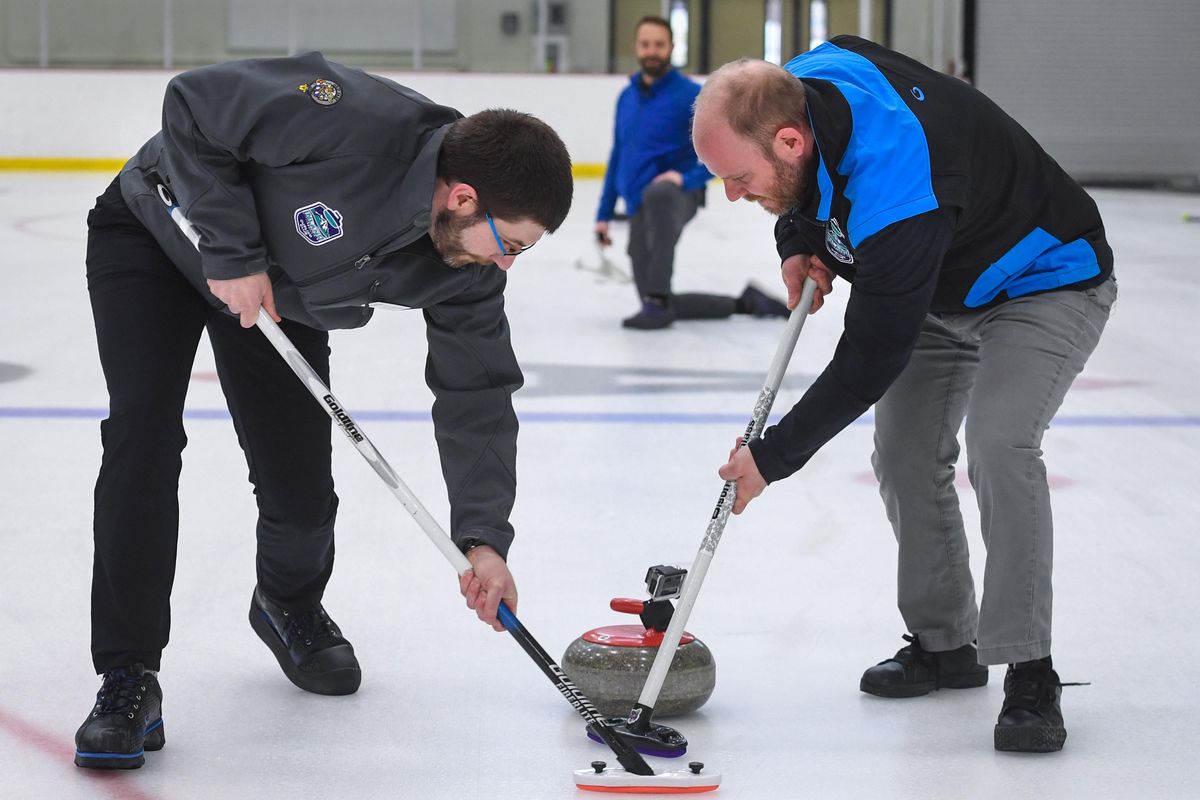Angela Schneider: Leave it to the amateurs, even experienced ones, to take a spill ahead of USA Curling Nationals

Settling into the hack, I said to myself over and over again, “Don’t fall.”
Don’t fall.
Don’t fall.
I fell.
Landed flat on my face.
It at least wasn’t too far to go, but Spokesman-Review photographer Dan Pelle caught it all on camera.
There I was, the former curling columnist from Canada sprawled out on the ice.
I’ve been here before.
Twenty-two years ago, in fact.
New to Western Canada and working as the sports editor in Kamloops, B.C., where we would be hosting the World Curling Championships in 1998, I took a learn-to-curl clinic.
I had covered tournaments (called bonspiels) in Newfoundland and had an idea of how the sport worked, but once I saw the big guns in action at the Worlds, I fell in love.
It was all strategy, big shots and camaraderie.
I moved on to the Calgary Sun, where I was given the opportunity to interview some of the world’s biggest curling names: Randy Ferbey, Kevin Martin, John Morris, Colleen Jones.
Now I find myself in Spokane, new to The Spokesman-Review and asked to write about the USA Curling National Championships in Cheney from Saturday through Feb. 15.
And sent to a learn-to-curl clinic.
I know the game better than I can play it, that’s for sure. I’ve thrown maybe 20 rocks in my lifetime, including a media event for the Worlds where three-time champ Peja Lindholm and his Swedish rink made the bunch of us look like clowns.
So I was shaky as I settled into the hack. Of course, pride goeth before the fall.
And fall I did.
Not on the first throw, or the second or third. More like my fifth, when I really should have had my ice legs under me.
Oh well.
My shame doesn’t diminish my excitement to see high-level curling come to Spokane.
Matt Moore, president of Inland Northwest Curling, is just as excited. He fell in love watching curling’s inaugural medal event at the 1998 Nagano Olympics.
“It’s an amazing sport,” he said. “There’s a complexity to it. Every shot means so much. The strategy is unreal.”
He didn’t start playing, though, until 2012 when his wife signed them both up for a learn-to-curl clinic in Chicago.
They found out she was pregnant and put their curling career, one that would cost $1,000 in club memberships, on hold. They revisited the idea two years later and joined a new, less expensive club, Windy City Curling.
In short time, Moore found himself at a bonspiel curling against some older, much more experienced Canadians.
“We were all fairly new and, all of a sudden, we were taking it to this Canadian team, right to the last end,” he said. “The thing was, the entire club was behind us and cheering for us.
“It really was like family supporting each other.”
When he and Niki moved to Spokane for work, he dove back in.
The Inland Northwest club formed about a year ago, merging the Lilac City and Coeur d’Alene clubs. The Lilac City club had become inactive since losing their ice when the city closed the Riverfront Park sheets to build the Ice Ribbon.

The new club curls out of Frontier Arena in Coeur d’Alene but it competes against hockey and figure skating for ice time.
“We’re hoping enough people fall in love with curling during the nationals that we fill our learn-to-curl clinics in March and our beginner leagues in April,” Moore says.
Sure enough, the game is easy to love.
Entry into the game is not that expensive (I priced out a gripper, a slider and a broom at $120 and $20 for the clinic).
It’s good exercise.
It’s a brain game – like chess where you have to stay three moves ahead of the other guy.
It’s exciting. No, really. Wait until you see defending men’s champ and Olympic gold medal winner John Shuster throw a raise double takeout to clear the house.
And it’s fun. Even falling.
